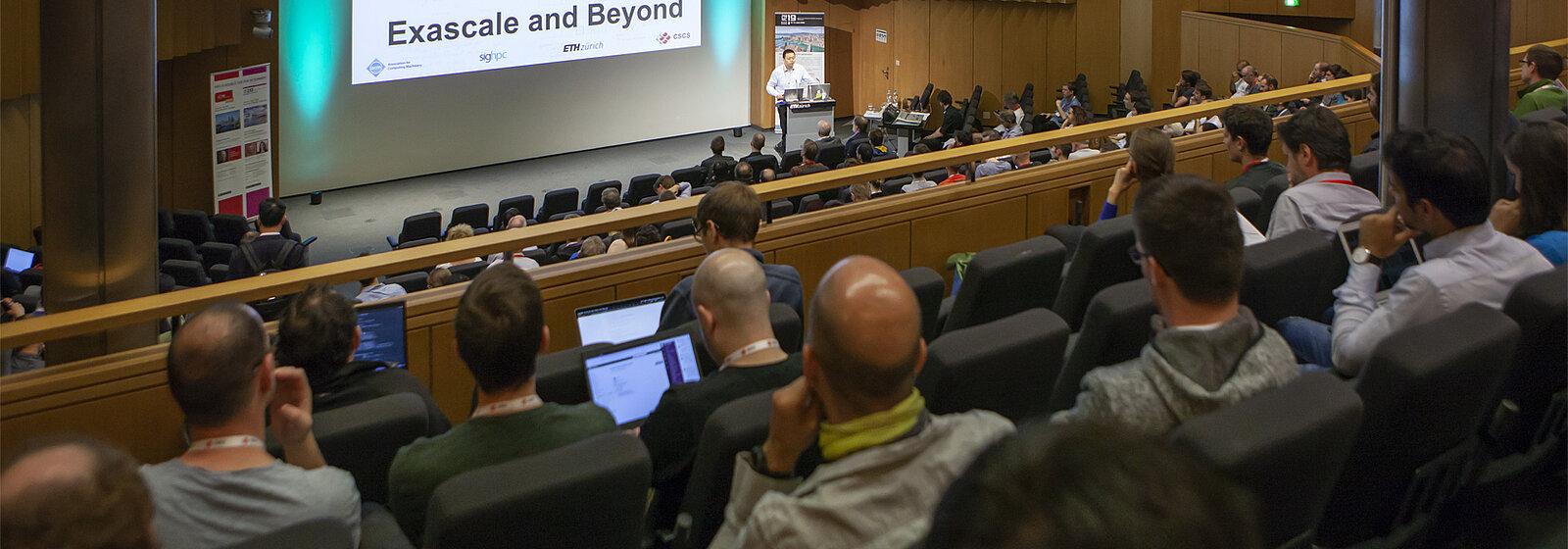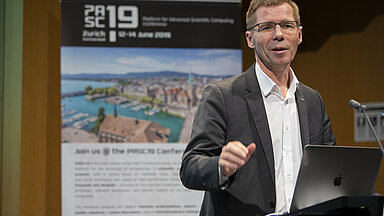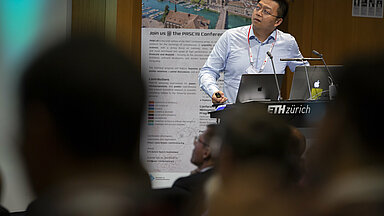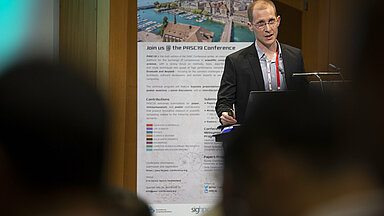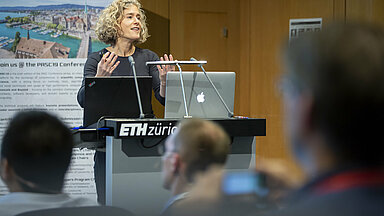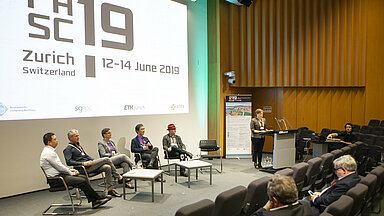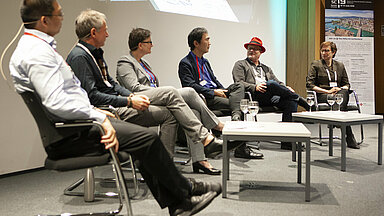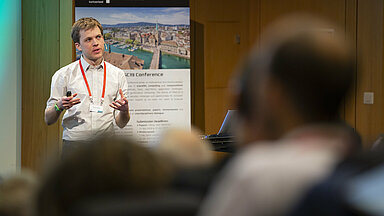June 25, 2019 - By Sarah Waldrip
The theme for PASC19, “Exascale and Beyond”, comes on the heels of the official announcement earlier this year that the world’s first operational exascale computer is scheduled to be completed by 2021 in the United States. PASC19’s schedule of events featured talks, panels and presentations centered on the shared challenges and opportunities that computer architects, software developers and domain experts will face in the coming era of exascale computing systems.
Co-chairs for this year’s conference were Haohuan Fu of the National Supercomputing Center in Wuxi, China, and Simon Scheidegger of the University of Lausanne, Switzerland. They each contributed a great deal to the planning and execution of the conference, serving as discussion leaders and support for the many other presenters at PASC19. There were five hour-long keynote presentations, a panel discussion, a second installment of an interdisciplinary dialogue session, and 55 mini-symposia sessions covering many different scientific fields; there were also 17 academic paper presentations, including one that was crowned this year’s best academic paper submission, as well as a scientific poster competition—all squeezed into three days.
Variety Brings Life to Keynotes
Each of the keynote presentations represented a different perspective on the possibilities and challenges of exascale computing. Topics included computational bioscience, innovative data transfer and storage technologies, instabilities in aerospace propulsion systems, large-scale optimization strategies, and scalable, high-performance architectures with embedded photonics.
Wednesday morning’s keynote from Dan Jacobson, Chief Computational Scientist in the Biosciences Division of Oak Ridge National Laboratory in the United States, started off the conference with a glimpse into the complexity of biological genetic architectures, emphasizing that in order to study the relationship between an organism’s genetic evolution and its environment, one must utilize collective gene analysis rather than study one individual of a species. This “pan-genome” approach requires an immense amount of computing power in order to calculate and model the estimated 10170 potential interactions among variants, something that is only now beginning to look possible with the development of exascale computing. This combination of Big Data and high-performance computing (HPC) has the potential to bring bioscience into a new era for bioenergy and human health research, and perhaps even open the door to engineering organisms specifically to thrive on Mars.
Thursday morning’s keynote, sponsored by Microsoft, was presented by Scarlet Schwiderski-Grosche of Microsoft Research Division in Cambridge, United Kingdom. She explained that cloud-based technologies must adapt radically in order to keep up with the exponential growth of the “data tsunami” that is doubling in volume every two years, but also remain cost effective. The answer partially lies in faster networks in data centers and partially in better data storage. One possible solution that Schwiderski-Grosche’s research team is developing is a new type of optical network that uses a tunable laser and custom-built optics chips that would allow for speed-of-light networking between the server racks in a data center; by assigning each rack an individual light frequency, or color, they can communicate packets of information with one another almost instantaneously and save researchers enormous amounts of time moving data. In regards to archival data storage, she revealed Project Silica, which has had success in storing massive amounts of data inside small, lightweight, environmentally resistant silica glass lenses—a breakthrough for cloud storage centers. Femtosecond lasers encode data inside the 3 cm-wide glass lenses; these tiny indentions inside the glass are practically immune to degradation or damage.
Professor of electrical engineering and Director of the Lightwave Research Laboratory at Columbia University, Keren Bergman delivered the final keynote of PASC19, entitled “Flexibly Scalable High-Performance Architectures with Embedded Photonics”. As a member of the U.S. Department of Energy’s Advanced Scientific Computing Advisory Committee, she will be among those overseeing the deployment of the first exascale machine at Argonne National Laboratory. She explained that in order to make this exascale computer energy-efficient, the goal has been set to run it with only 20 MW per year. This is an ambitious goal, but with photonic networking instead of electronic, it is theoretically possible to implement “distance-independent energy for data movement,” while also having unprecedented flexibility and higher bandwidth density. This would not only save a tremendous amount of energy (i.e. money), but it would also make the distance between communicating computer nodes virtually irrelevant, which means much faster application run-times (as much as 70 percent increase in speed by some estimates).
Panel Encourages Dialogue Among Experts
The panel discussion on the evening of June 12 centered solely on the theme, “Exascale and Beyond”, motivating a discussion about sustainable software in the face of the exascale transition, and also continuing an industry-wide debate about whether GPU systems are in fact the productive way forward for all the varied types of research and applications. The panel was moderated by emerging exascale software specialist Lois Curfman McInnes (Argonne National Laboratory, USA) and HPC technology pundit Rich Brueckner (InsideHPC). Guest panelists were Peter Bauer (ECMWF, UK), Satoshi Matsouka (RIKEN, Japan), Michela Taufer (University of Tennessee, USA) and Haohuan Fu (National Supercomputing Center Wuxi, China). Watch the full panel discussion here.
Academic Paper Awarded Best of PASC19
From among the 17 academic papers presented throughout the conference, one was selected for special recognition: “Accelerating High-Resolution Weather Models with Deep-Learning Hardware” was awarded the Best Paper at PASC19. The author of the paper, Sam Hatfield, will graduate from the University of Oxford (UK) this year and has plans to begin working with The European Centre for Medium-Range Weather Forecasts (ECMWF) soon after. He spoke highly of his experience at PASC19 and expressed interest in participating in the coming year’s PASC20. “I am moving to ECMWF at the end of the year, so maybe if I am very quick at starting up there, I will have something to present next year,” he said. “I think it would also be really nice to be a part of a mini-symposium like the ones we saw here this year.”
Planning Underway for PASC20
PASC19 organizers took great care to assemble a diverse group of attendees from around the globe who represent a wide variety of scientific disciplines and institutions, extending the discourse beyond the scope of computing and computer science to include ideas and concerns of application builders and HPC users who must also adapt to a future shaped by exascale computing. By promoting this interaction among differing scientific perspectives, PASC19 organizers succeeded in facilitating valuable exchanges of ideas across both disciplines and geographic borders.
“I see a lot of progress that people are making, for instance the many new applications and the US colleagues doing very exciting things on their Summit system,” said conference co-chair Haohuan Fu after the conference had concluded and plans for next year were announced. “The ECMWF with exploration and mixed precision in weather and climate modelling is something I have already forwarded to my students to learn about.”
PASC20 will take place in Geneva, Switzerland, from June 29–July 1, 2020. Co-chairs for PASC20 will be Bastien Chopard of the University of Geneva, Switzerland, and Sinéad Ryan of Trinity College Dublin, Ireland, and the theme will be “New Challenges, New Computing Paradigms”.
Further information
Here you can find the entire photo gallery of PASC19 >
